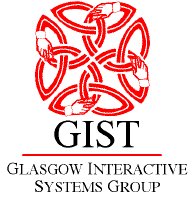 The Multimodal Interaction Group website has moved. Click here to visit the new site
The Multimodal Interaction Group website has moved. Click here to visit the new site
Earcon Experiments
As mentioned, Meera Blattner developed the idea of earcons in 1989 [25]. However, she never tested them to see whether they were effective and if listeners could extract information from them. That is why we did our experiments. The earcons you can listen to here were designed using improved guidelines for creating earcons derived from our experiments (click here to see the guidelines). The Figure 1 shows the layout of a screen shown to train participants for our experiments to investigate hierarchical earcons (click here to find out what these are). The experiments just tested earcons, they did not suggest that earcons should be used to represent files and folders in this way in a real interface.
Figure 1: Phase I training screen - click on the icons to hear the earcons.
You can download a HyperCard stack (400K) containing these earcons.
Each of the icons on the display had a sound attached to it. The sounds were structured as follows: Each family of related items shared the sametimbre (musical instrument). For example, the paint program, the paint folder and paint files all hadthe same brass instrument. The write family has a piano timbre, the draw family a marimba and HyperCard a flute. Items of the same type shared the same rhythm. Forexample, the programs all had the same rhythm, the folders another and the files another. Items in the same family and of the same type were differentiated by pitch. For example, the firstWrite file was at pitch C2 (523Hz) and the second Write file was at C4 (130Hz).
As you can see a simple hierarchy was created. All of the information available graphically in the icons was available through sound in the earcons. Listen to some of the earcons and hear the families and types. It is very easy to add new elements. To add another family, for example spreadsheet, all you need is a new timbre. You can then use the rhythms to create instances of files, folders and applications. Since this initial experiment we have gone further with hierarchical earcons. We have tested bigger hierarchies (with over 30 nodes) over longer periods of time (recall after one week). For full details see my publication list or this paper.
Figure 2 shows the screen for the second part of our experiment, this time investigating menus. Each menu had its own timbre (violin for menu 1, electric organ for menu 2 and a 'fantasy' sound for menu 3). The items on the menus were differentiated by different rhythms, timbres and pitches.
Figure 2: Phase II training screen
You can download a HyperCard stack (400K) containing these earcons.
Prof Stephen Brewster
Department of Computing Science,
University of Glasgow,
Glasgow, G12 8QQ, UK
Tel: +44 (0)141 330 4966
Fax: +44 (0)141 330 4913
Email: stephen@dcs.gla.ac.uk
Last Modified: December 29, 1998